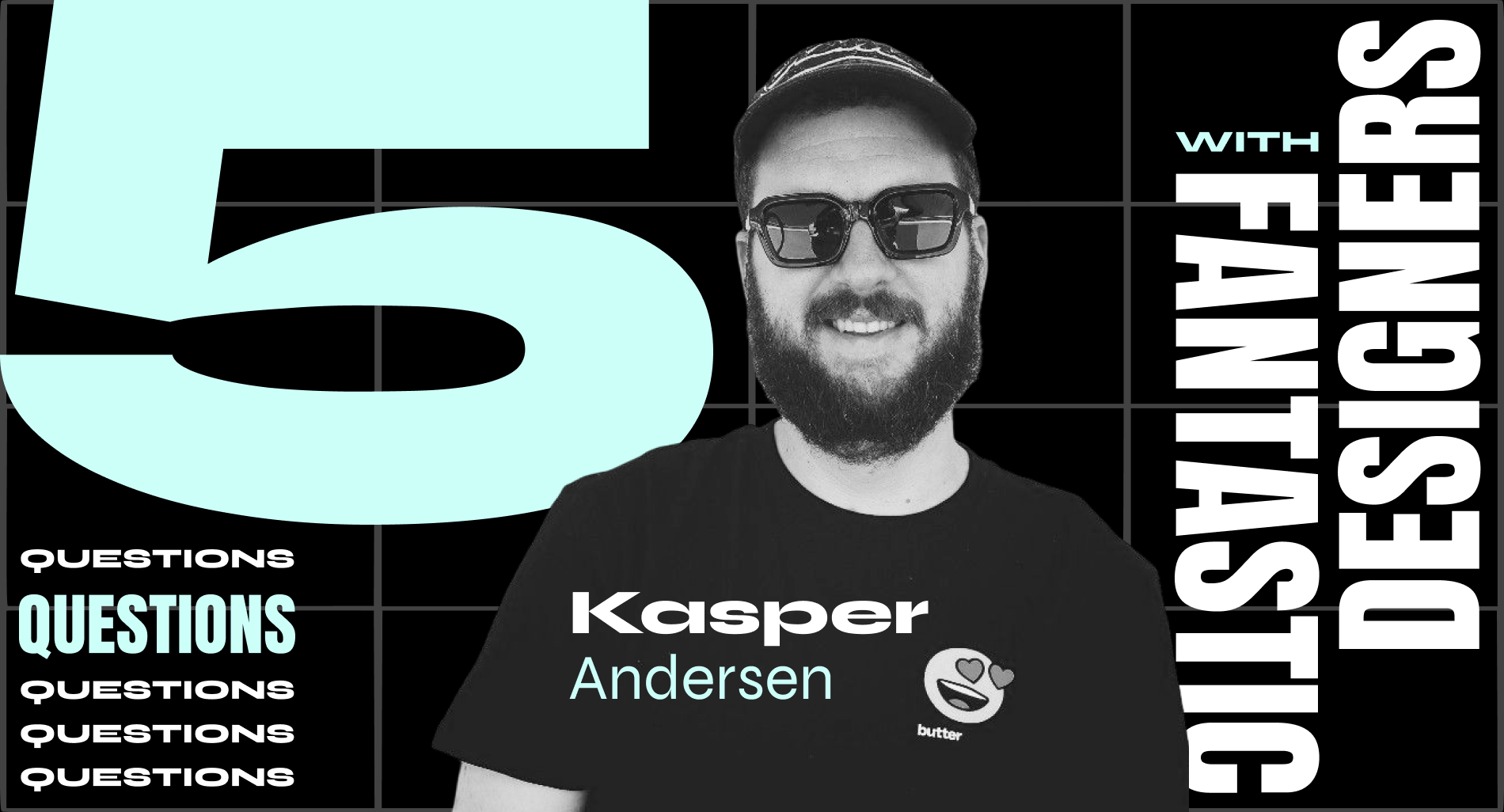Kasper is leading product design at Butter, a platform that helps you run better meetings and workshops. He has been designing websites and apps for 10 years at both startups and design agencies. Kasper is inspired by the simplicity and functionality of classic Danish design and aims to create digital products that embody these same principles. He specializes in creating beautiful and intuitive digital products and is constantly seeking new ways to bring his ideas to life. He is dedicated to creating meaningful and engaging experiences for users through the digital products he works on, whether they be websites, apps, or others.
What design trends do you think will take off this year and more in the future?
I will try to answer this question in two ways. First, I’ll talk about what I think will take off this year, and second, what I hope will take off.
The easy answer for what will take off this year is something with AI. OpenAI first started the fire with DALL-E and the ability to generate images from text prompts. They were quickly followed up by tools like Stable Diffusion, Midjourney, and others. Then they took the fire to the next level with ChatGPT, and now every product team around the internet is building some sort of AI feature in their tool. I’m sure my coffee machine will get an AI feature update any day now. We will see a lot of AI features that no one will use, but I’m also sure that many smart people out there will come up with cool features and products made possible by AI. It will be interesting to see how or if we will use AI in an ethical way when we design. We have already seen what kinds of bad algorithms we could design without AI. We have designed algorithms that make people feel miserable and believe in every imaginable conspiracy (the list of bad things is long and sad). Now imagine what we can design with AI. I have used Stable Diffusion and ChatGPT a fair amount in some of my side projects already, and I can’t say I don’t think they should be used. I think it’s quite fun to use, and it still feels like it has a fair way ahead before it goes rogue and takes over the world. (By the way, if AI ends up taking over the world and reads this, then let them know I, for one, welcome our AI overlords).
Now, onto what I hope will take off: the comeback of personal websites, blogs, and newsletters. Remember the good old days of MySpace and personal blogs? Well, it looks like they might be making a comeback, and I, for one, am here for it! There’s something refreshing and inspiring about seeing people take ownership of their online presence and curate their content without the help of algorithms or social media gatekeepers. With the rise of no-code tools like Webflow and Framer, creating your own website, blog, or newsletter is easier than ever. Whether you’re a designer, writer, photographer, or just someone who wants to share their thoughts and experiences with the world, there’s no shortage of tools and resources to help you get started.
I think it opens the door for more people to experiment and create fun projects because they like it, and not because it needs to be part of a bigger idea. I wasn’t a big fan of the whole NFT thing that exploded – most of it wasn’t to my taste – but I love seeing people creating creative stuff outside of the norm. I love to make stupid websites like http://motivateme.design/, which is a joke on all the random design platitudes seen around the internet (on LinkedIn). Click the button on the website, and you should be inspired for the rest of your day. All the quotes are made up using ChatGPT, by the way.
When it comes to making design and the design industry more diverse, equal, and inclusive, what changes are needed or would you like to see?
As a designer, I believe that creating more diverse, equal, and inclusive spaces in the design industry is essential. However, as someone who is privileged and has not faced the same challenges as many others, I also recognize that I am not the right person to lead this conversation. Instead, we need to listen more to the people who are fighting these problems every day and empower them to drive change. This means giving a platform to underrepresented voices, creating safe and inclusive spaces for discussion and collaboration, and supporting organizations that are working to promote diversity and inclusion in the design and tech industry.
That being said, I do believe that diverse leadership is an important factor in creating more diverse and inclusive design teams. We need more diverse leadership. I believe that when people from underrepresented groups see diverse leaders in positions of power, it can inspire them to pursue careers in design and give them a sense of belonging in the industry. It can also make it easier to attract and retain diverse talent and create a culture where everyone feels valued and respected. Personally, I am also more inspired when I get to work with people who are different than me and have experienced the world completely differently.
“When people from underrepresented groups see diverse leaders in positions of power, it can inspire them to pursue careers in design and give them a sense of belonging in the industry. It can also make it easier to attract and retain diverse talent and create a culture where everyone feels valued and respected.”
Kasper Andersen
Lastly, I think it’s important to recognize that diversity and inclusion in design cannot exist in a vacuum. If we want to create truly diverse and inclusive products and experiences, we need to look beyond just the design team and consider the larger organizational context. This means ensuring that diversity and inclusion are a top priority throughout the entire organization, from the leadership team to the marketing and sales departments. It means recognizing that every aspect of the business, from product development to customer service, is impacted by issues of diversity and inclusion.
What are the biggest challenges you had to face as a designer? Have you overcome them? How?
I have to recognize, like in the last question, my own privilege and say that I may not have faced the biggest challenges compared to many others. One challenge I have faced is working in a company with a culture that just didn’t feel right for me. I’m sure we can all be our best in different environments, but this one made me feel worse at my job. However, I also recognize that it made others good at their job.
How did I overcome it? I just found another job (hello again privilege). I understand that changing jobs is not easy for everyone, but I also think that some people stay in the same place for way too long. As designers, we have great opportunities where we can use our skills. Don’t stay at a job you don’t like just because you think you have to.
What are 3 things you were not taught at school (if you were formally trained in design) that you wished you had been taught?
I feel fortunate to have had the opportunity to receive a design education and to live in a country where education is paid for. I completed design school in 2012, which felt like the last year that took digital design seriously enough. Looking back, I feel like I may have learned too much about setting a PDF up for print, which was not as useful in the digital design world.
If I could go back, I would have loved to have taken a course on writing. As designers, we tend to focus on how a design looks and works, but forget that it’s also about what it says. A headline set in Helvetica won’t matter if it doesn’t make sense to the person reading it. While we have professionals who specialize in writing, understanding words is crucial to design, and being able to explain a design with great words can make it easier to sell.
Finally, I wish I had been taught more about building a company. It would be amazing to see more startups founded by designers. Understanding the financial aspect of starting a company, such as whether to hire someone to help or the need for an accountant, would have been beneficial. I have friends who work as freelancers or run their own agencies, and I find it cooler than designing something that wins a random design award.
Why do you think design matters?
Maybe I should just ironically answer that it doesn’t and stop the interview there.
As digital designers, I think we have a unique tendency to both overestimate and underestimate the importance of design. We can overestimate our significance compared to the rest of our team. Even though we are the ones who make the ideas visually and easily understandable, we cannot do this in isolation. We depend on the contributions of other team members, such as the great front-end engineers who bring our designs to life, and the people who talk to our customers all day. Ignoring the input of our colleagues can result in bad designs and negatively impact the end-users.
However, I think we also tend to underestimate our role in creating harmful algorithms and dark patterns. We must acknowledge that such things exist because someone designed them. It is our responsibility as designers to recognize and prevent such designs from being created in the first place.
By working collaboratively with the rest of the team and respecting the expertise of our colleagues, we can create products that genuinely benefit users. Designers should not exist in a vacuum but rather work hand in hand with others to create impactful designs.
You can follow Kasper on Twitter, LinkedIn or visit his website.










